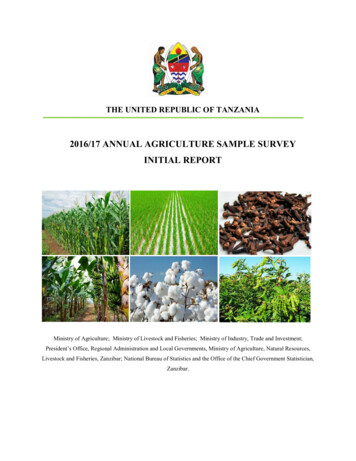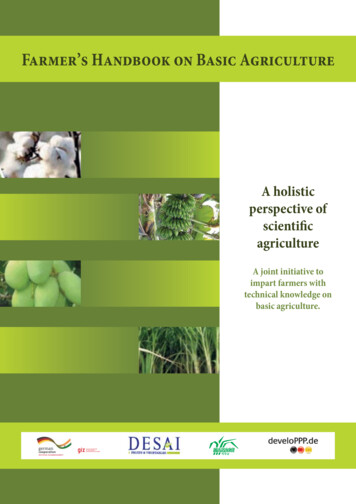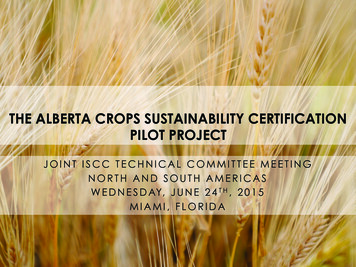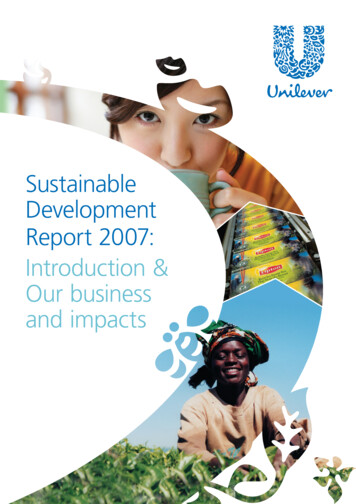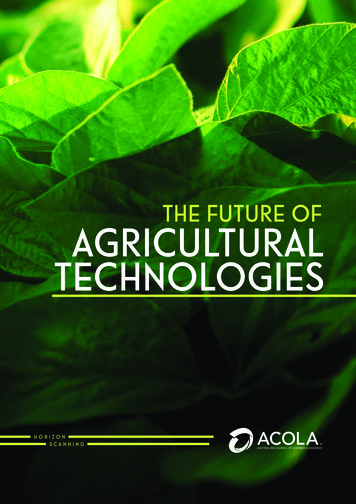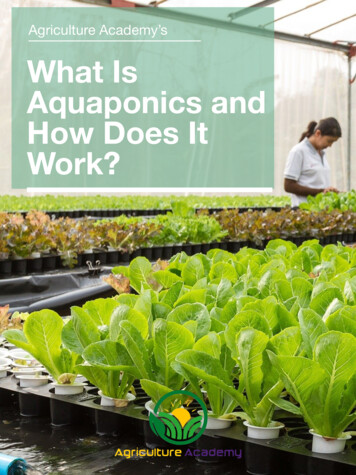
Transcription
Agriculture Academy’sWhat IsAquaponics andHow Does ItWork?
Introduction to HydroponicsThank you for downloading this guide!In this eBook we are going to take a look at aquaponics. What isaquaponics? How does it work? What do you need to get started? All ofthese questions are going to be answered in this guide.2
What is AquaponicsNow, let’s get started by answering the question ‘What is aquaponics?’. In anutshell, the name says it all. ‘Aqua’ means water and ‘Ponics’ means towork, or grow. So basically, aquaponics is a method of growing plants inwater and using this as a habitat for rearing fish too.By growing plants and raising fish aquaponically, you take advantage of thebest of both hydroponics and aquaculture. In hydroponics, you are merelygrowing your plants in water which most often gets pumped out the system.In aquaculture, toxic nutrient accumulation from the fish, fish food and fishwaste means the water also needs to be constantly siphoned off andreplaced with a clean supply. However, both these problems are solved in amutually beneficial way in aquaponics. Not only is water saved through thecontinuous cycling from the fish, to the plants, and back to the fish again, butthe plants are able to use up the toxic nutrients making the recycled watersafe for the fish again.How Does it Work?Now that we have defined aquaponics, we need to understand how theprocess works. There is 1 process at the core of the system upon whicheverything depends. This process is the nitrogen cycle. If you remember, wementioned that by placing plants into the system they clean the water andmake it safe for the fish again. The nitrogen cycle makes this all possible. Itall starts with ammonia. Ammonia is a waste product from the respiratorycycle of the fish, as well as decomposing fish food and fish waste. Whenammonia accumulates in high concentrations, it becomes toxic to the fish.On every dark, wet surface in the aquaponics system exist nitrifying bacteriaknown as Nitrosomonas. These are naturally occurring and extremelybeneficial because they convert the ammonia to nitrite. Unfortunately, nitriteis even more toxic to the fish than ammonia. Luckily, there is another classof bacteria called Nitrobacter, which convert the nitrites to nitrates. And thisis fantastic because nitrates are a great nutrient source for the plants. So, as3
you can see, the nitrogen cycle is an extremely important process that convertstoxic waste products into less toxic nutrients that the plants can use.What Are Biofilters and Why Do I NeedThem?Now that the importance of the nitrogen cycle and the beneficial bacteria havebeen made clear, we are going to highlight the role of something called a‘biofilter’. Biofilters can be made of any inorganic substance, like gravel or ahydroponic substrate for example, and are included in an aquaponics system toprovide a place for the beneficial bacteria to live and proliferate. The biofiltersprovide a large, dark and wet surface area on which the Nitrosomonas andNitrobacter survive. Water from the fish tanks is pumped through these biofilters,the ammonia gets converted to usable nitrates, the water then goes to the planttanks, the nitrates are used, and the water is now safe to return to the fish tanks.4
Equipment to Get StartedIf you are feeling inspired to start your own aquaponic endeavour, then you aregoing to need some important equipment to get started. We are going to list themost basic products that you can use to build a simple system, perfect if you area beginner. First of all, you will need a fish tank. This can be made from avariety of materials, like stainless steel, lined wood or plastic. The size of thecontainer will depend on how many fish you are wanting to stock. Secondly, youwill need some media beds which you will use to grow your plants in. Mediabeds can be made from similar materials to the biofilter, like gravel or ahydroponic substrate. If you are thinking of growing your plants on floating trays,then you will also need some raft beds. Whilst your media beds can serve thesame purpose as a biofilter, you may wish to include a separate system intoyour design if you have the space and resources to do so. In order to circulatewater throughout the system, you will need water pumps. In order for these towork, you are going to need to connect them to an electrical system. This cancome from the grid, or be solar, depending on your preferences. If you live invery hot or cold regions, then you may also want to invest in water heaters orcoolers to warm the water in the winter and cool it in the summer.Top Tips for Aquaponic BeginnersTip #1: Start small. If you have little to no experience in aquaponics, rather startwith a small system and expand as your experience and confidence progresses.Tip #2: Choose your plant and fish wisely. If you are wondering which species isbest for you, first take a look at those that grow best in your climate. Trying torear cool water fish in tropical areas can be quite difficult and increase the costsof cooling the water. It is also important to use complimentary fish and plantspecies.Tip #3: Test your water regularly. Fish are extremely sensitive to nutrient and pHfluctuations. It is therefore important to take daily, or at least weekly, waterreadings. You can purchase simple, cheap kits online or from aquaponic stores.5
What is Aquaponics Now, let's get started by answering the question 'What is aquaponics?'. In a nutshell, the name says it all. 'Aqua' means water and 'Ponics' means to work, or grow. So basically, aquaponics is a method of growing plants in water and using this as a habitat for rearing fish too.



